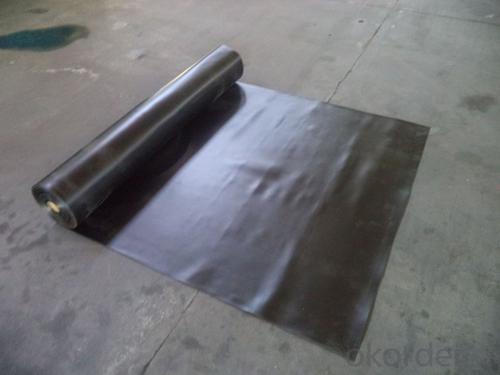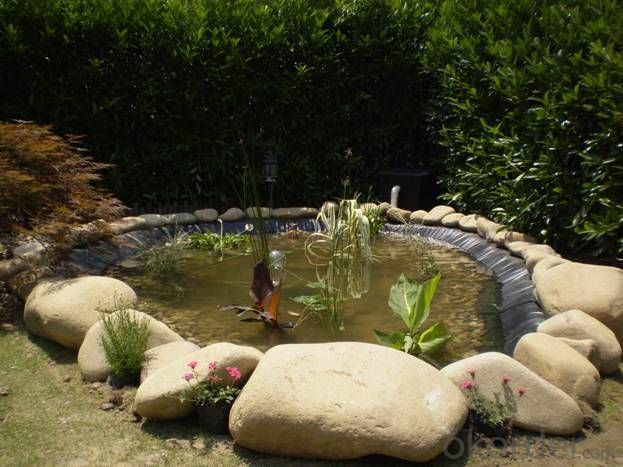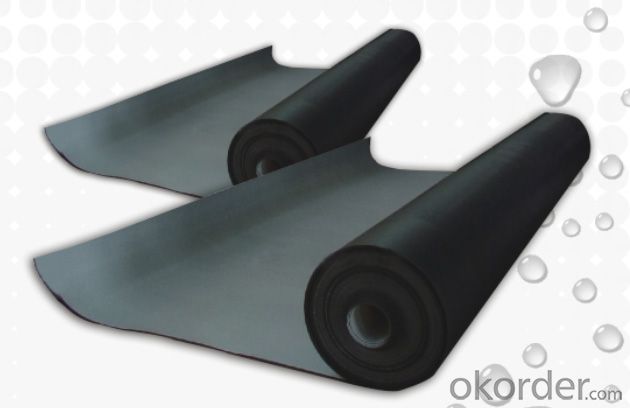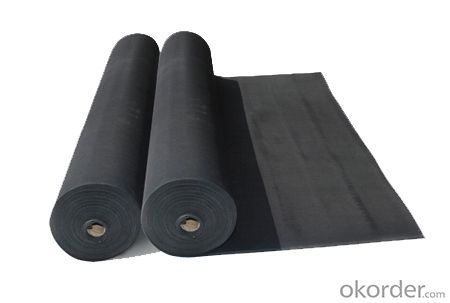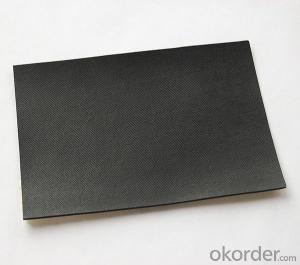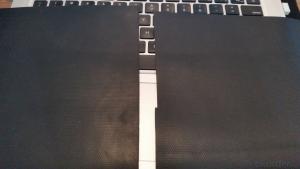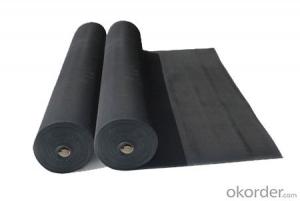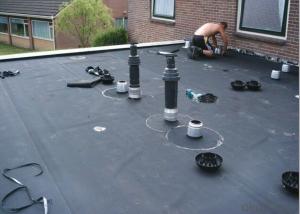EPDM Rubber Material Waterproof Membrane for Road Base
- Loading Port:
- Shanghai
- Payment Terms:
- TT OR LC
- Min Order Qty:
- 50000 m²
- Supply Capability:
- 5000000 m²/month
OKorder Service Pledge
OKorder Financial Service
You Might Also Like
EPDM Rubber Material Waterproof Membrane for Road Base
Description Of EPDM Rubber Material Waterproof Membrane for Road Base:
This waterproof coiled material is of high elasticity with best performance among high polumer waterproof coiled material in the world.It is also the most typical one in the world.Waterproof coiled material made of ternary ethylene-propylene rubber is produced with the use of the most advanced contiuous extrusion and vulcanization technology and related equipments which are specially designed for production of such product.It is good in compactness,without bubble and performance difference in length and breadth,perfomances reach or exceed the demands of GB18173.1-2000 standard.
Main Features of EPDM Rubber Material Waterproof Membrane for Road Base:
1.EPDM waterproof membrane for bridge engineering waterproof
2.EPDM waterproof membrane for water conservancy projects ,such as river bank,lake dam seepage.
3.EPDM waterproof membrane for the municipal engineering.
4.EPDM waterproof membrane for aquaculture.
Specifications of EPDM Rubber Material Waterproof Membrane for Road Base:
| Number | Item | Unit | Value | |
| 1 | Size Variation | Thichness | % | ±10 |
| Width | % | ±1 | ||
| Length | % | Allowed negative | ||
| 2 | Breaking tensile strength at normal temperature | Mpa | ≥7.5 | |
| Breaking tensile strength at 70°C | Mpa | ≥2.3 | ||
| 3 | Breaking elongation at normal temperature | % | ≥450 | |
| Breaking elongation at -20°C | % | ≥200 | ||
| 4 | Tear strength | KN/m | ≥25 | |
| 5 | Impermeability(30min) | * | 0.3Mpa no leakage | |
| 6 | Bending at low tempreture | °C | ≤-40 | |
| 7 | Stretch tensor at heating | Elongate | mm | ≤2 |
| Shrink | mm | ≤4 | ||
| 8 | Air oven aging(80°C×168h) | Tensile strength at break retained | % | ≥80 |
| Elongation at break retained | % | ≥70 | ||
| 9 | Anti-alkali | Tensile strength at break retained | % | ≥80 |
| Elongation at break retained | % | ≥80 | ||
| 10 | Nuture weathing at manual simulation | Tensile strength at break retained | % | ≥80 |
| Elongation at break retained | % | ≥70 | ||
Applications of EPDM Rubber Material Waterproof Membrane for Road Base:
Widely used in roofs, basement, toilet ,swimming pool, and all kinds of industry and civil building waterproofing, reservoir, vivicism, bridge, underground, tunnel and dam waterproofing ,especially to the keystone waterproofing projects which is durability, high corrosion resistance and easy deformation.
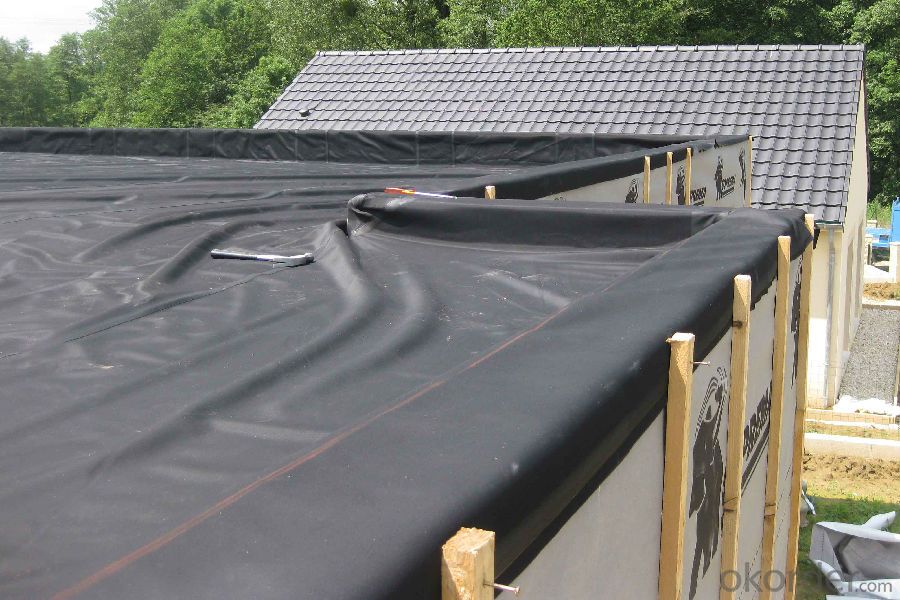


IMages of EPDM Rubber Material Waterproof Membrane for Road Base:
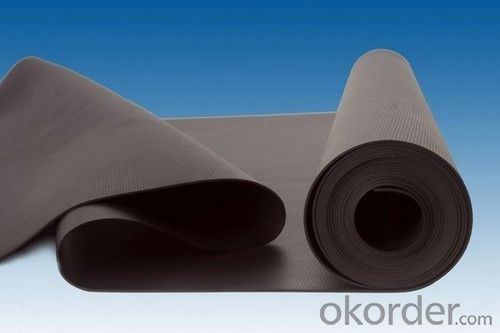



FAQ of EPDM Rubber Material Waterproof Membrane for Road Base:
1. What are we supplying?
We are specialized in producing Colorful Asphalt Roof Shingle, SBS/APP modified bitumen waterproof membrane, Self adhesive bitumen waterproof membrane, PVC waterproofing membrane, EPDM rubber roofing membrane, Single Component Polyurethane Waterproof Coating, and Spray Polyurea Waterproof Coating
.
2. How Many years experience do we have?
We have been exported to more than 20 countries in the past 15 years.
3. How long do we usually reply your request?
We always reply our customer within 24 hours.
- Q: Can a waterproofing membrane be used on stainless steel surfaces?
- Yes, a waterproofing membrane can be used on stainless steel surfaces. Stainless steel is a durable and non-corrosive material that is commonly used in various industries. However, it is not completely immune to water damage or corrosion, especially in harsh environments. Applying a waterproofing membrane on stainless steel surfaces can provide an additional layer of protection against moisture, preventing potential water damage, rusting, and corrosion. It is important to ensure that the waterproofing membrane is compatible with stainless steel and applied correctly to ensure proper adhesion and long-lasting protection.
- Q: Is a waterproofing membrane resistant to rodent or insect infestation?
- Yes, a waterproofing membrane is typically resistant to rodent or insect infestation. The membrane acts as a physical barrier, preventing pests from accessing the underlying structure. However, it is important to ensure proper installation and maintenance to minimize any potential vulnerabilities that could be exploited by pests.
- Q: Can a waterproofing membrane prevent water leakage in basements?
- Yes, a waterproofing membrane can prevent water leakage in basements. A waterproofing membrane is a protective layer that is applied to the exterior or interior walls of a basement to create a barrier against water penetration. It can effectively prevent water from seeping through the foundation walls and causing leaks or moisture issues in the basement. The membrane acts as a waterproof seal, preventing water from entering the basement and protecting the structure from potential damage. However, it is important to note that the effectiveness of a waterproofing membrane depends on its proper installation and maintenance.
- Q: What is the use of waterproof membrane?
- Therefore, the role of waterproofing membrane in waterproof construction can not be ignored.
- Q: Can a waterproofing membrane be used on nickel surfaces?
- Yes, a waterproofing membrane can be used on nickel surfaces. The membrane will provide a protective barrier against moisture and prevent water penetration into the nickel surface.
- Q: Can a waterproofing membrane be used on both interior and exterior walls?
- Yes, a waterproofing membrane can be used on both interior and exterior walls. Waterproofing membranes are designed to prevent the penetration of water or moisture into the walls, regardless of whether they are located on the interior or exterior of a building. These membranes are typically made from materials such as rubber, modified bitumen, or liquid-applied coatings, and they provide an effective barrier against water infiltration. By applying a waterproofing membrane on both interior and exterior walls, you can ensure the long-term protection of your building from water damage, mold growth, and other moisture-related issues.
- Q: Can a waterproofing membrane be used on bridge decks?
- Indeed, it is possible to utilize a waterproofing membrane on bridge decks. These decks are constantly subjected to diverse weather patterns, encompassing rain, snow, and ice, which, over the course of time, can lead to detrimental effects. By applying a waterproofing membrane to bridge decks, one can effectively safeguard the concrete against moisture infiltration, thus averting decay and extending the bridge's lifespan. Moreover, this waterproofing membrane acts as a barrier that thwarts chloride ions, notorious for hastening the corrosion of reinforcing steel within the bridge deck. Consequently, the incorporation of a waterproofing membrane on bridge decks is a customary protocol in bridge construction and maintenance, serving as a guarantee for their endurance and longevity.
- Q: Can a waterproofing membrane be used for roofing applications?
- Indeed, a waterproofing membrane can be utilized in roofing applications. Specifically designed to create a barrier against water infiltration, waterproofing membranes are commonly employed in a range of construction projects, including roofs. These membranes typically consist of durable materials like synthetic rubber, thermoplastics, or modified bitumen, renowned for their water-resistant properties and longevity. By installing a waterproofing membrane on the roof, one can effectively safeguard the building from water leaks and moisture penetration, which may result in structural damage, mold growth, and other related problems. The membrane is typically applied seamlessly onto the roof surface, forming a watertight layer that prevents water from permeating through. Waterproofing membranes for roofing applications are available in various types, such as sheet membranes, liquid or spray-applied membranes, or self-adhering membranes. Each type offers distinct advantages and suitability depending on the specific roofing requirements and construction conditions. In conclusion, a waterproofing membrane is indeed a viable choice for roofing applications, providing an efficient solution to ensure a durable and watertight roof system.
- Q: Can a waterproofing membrane be used in shower pans?
- Using a waterproofing membrane in shower pans is indeed recommended to prevent water leakage or damage to the underlying structure. This barrier prevents water from seeping through the shower pan and into the subfloor or surrounding walls, maintaining the integrity and longevity of the shower pan and the overall shower system. Furthermore, it also safeguards against mold and mildew growth, creating a safe and hygienic environment. Thus, incorporating a waterproofing membrane in shower pans is crucial for a durable and water-resistant shower installation.
- Q: Can waterproof sheets be used on steel roof panels?
- to resist the external rain, groundwater leakage can be curled into a roll of flexible building materials , As the engineering foundation and the building between the no leakage connection, is the entire project waterproof first barrier, the whole project plays a vital role.
Send your message to us
EPDM Rubber Material Waterproof Membrane for Road Base
- Loading Port:
- Shanghai
- Payment Terms:
- TT OR LC
- Min Order Qty:
- 50000 m²
- Supply Capability:
- 5000000 m²/month
OKorder Service Pledge
OKorder Financial Service
Similar products
Hot products
Hot Searches
Related keywords






